|
|
This is a sketch I did back in September but didn’t have time to post it, thought I’d share it now.
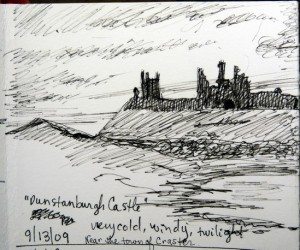 Dunstanburgh castle sketch Just thought I’d put this little tiny sketch up. Gary and I ended up here pretty late on a windy cold evening, but I still managed to sketch with my ink pen and wearing fingerless gloves. It was more like a shilhouette at this point, but as I started it I could still see the grass in front of it. It was scribbled pretty fast because I was so cold!
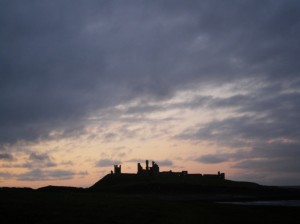 Dunstanburgh Castle at sunset Dunstanburgh Castle is on the East coast of Northumberland, just a short walk along the sea from the harbour Town of Crastor. We walked along with the rocky coast to our right, an area I’d love to explore more in the day time. Quite aways from the castle still is a fence with a gate you enter, there was a bench right there we decided to just sit because it had gone dark. That’s where I did my quicky sketch from, yet though it was quick, because I DID take the time to do it, I remember so much more about being there. Sometimes I prefer a scribbly looking sketch to a perfectly neat and tidy one, it can be much more expressive about the day or the feeling.
 Town of Craster Craster was small and quaint, has a kipper smokehouse, fishermen’s houses and a pub..perhaps a hotel? There is a small bay you can see here (though I know it’s dark!) where the fishing boats come in.
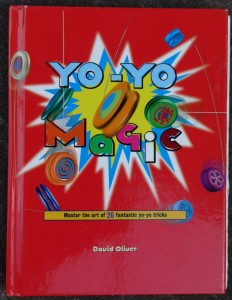 small book-cover sketchbook This is a picture of the special little sketchbook I made up. Once in awhile I throw this in my bag when I want to carry less and know I’ll be somewhere where quick sketches will be done. It’s an old book my kids didn’t want any more so I pulled the pages out to make this. (ouch, I know book lovers!! It was painless believe me) I cut nice watercolor paper the same height as the book and folded it acordian style to go inside, taping both ends onto the cover. I put a big rubber band around it to keep it shut or open to a certain page while drawing.
Today it was sunny and very blustery! We decided to take a hike near Clennell up the valley along the River Alwin then we looped back by walking up and along one of the huge hills. What gorgeous views we had! Of course I brought my field kit for watercolors with me hoping to find a quick sketch, as usual we pushed on without much lingering for painting or we’d never do the loop before dark. I did get some pencil sketches done that I later colored with watercolor as you’ll see.
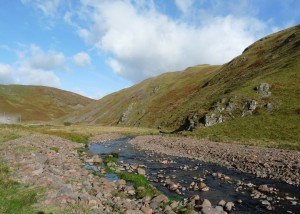 Along the Alwin River This is the valley we hiked along for a few miles, flat and easy except for the driving wind blowing on us at the start. It settled down as we got into the valley more. You can see on the far left a dust cloud with a huge truck in it, that’s a logging truck coming down the road we’re walking on, we’ll be headed around the base of that hill soon.
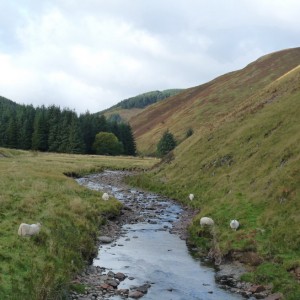 River Alwin into the Kidlandlee Dean As we walked occasionally a Grey heron would be spooked from the river and fly upstream a bit. We had the valley all to ourselves except for the sheep and maybe one passing truck. The Kidlandlee Dean is the forest area ahead; a Dean is a small ravine, a word that comes from the Anglo Saxon’s. At the base of those pine trees we’ll turn our path up to the right and go up onto the hill we’ve been hiking along side.
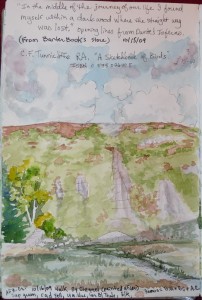 RIver Alwin and "The Dodd" (hill) Here I was able to convince Gary to stop long enough to let me catch my breath and sneak in a quick pencil sketch. This is just before we started to walk up the huge hill and I’m looking across the River Alwin and the Kidlandlee Dean is just to my left. The hill I sketched I found out later is called “The Dodd”. Later at home I painted the colors in with my waterbrush and watercolors while looking at the laptop photos. I put notes at the bottom of the colors I used.
 River Alwin below You can see we’ve been walking along the hillside, this is looking back towards the spot where I sat and sketched. We walked all along that ribbon of road down there! Along the way there are sheep that give you a look before running off into the grass, these two were right on the edge of the hill, it was pretty steep.
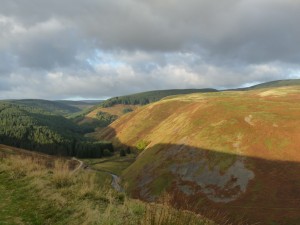 Hills called "The Dodd" and "Old Rookland" Looking back again; though the hills look bleak the colors on them of the bracken, grasses and grey-blue stone are really beautiful, but most especially when the sun hits it and creates dramatic shadows!
 An old Drovers road also called "Border County Ride" This is a view looking back along the road that we picked up on top of the hill. Gary says that it probably an old Drovers road, a drover being someone who’d be hired to drive cattle to market by the farmers 200 years ago or more. So they are English Cowboys I guess! Some 400 years ago they would have been using this road and would have to defend the cattle against the Border Rievers who could steal the cattle.
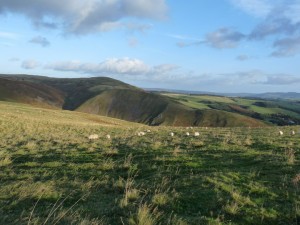 View of Clennell Hill This is a view looking across the valley (at the steep edge the sheep are on) to Clennell, we walked up that valley along the river. The wind was whipping but you can see the views were spectacular, so vast.
 View over Clennell towards Rothbury We sat here upon the top of this hill looking out over Clennell and Rothbury would be further on in the distance, Alwinton would be to our right. A farmer was burning some wood piles down below and it could be imagined that in ancient times when the Celts had their settlements there, there would be similar fires burning. Just below us to the right, on top of a smaller hill is the remains of a Celtic ring fort, at one time it would have had small fires burning in the crisp fall air.
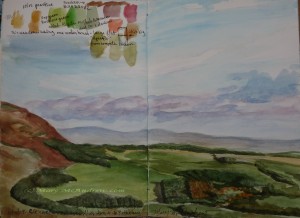 Watercolor sketch "Views over Clennell" We threw the waterproof picnic blanket on the ground and I sat to do a quick sketch. I just used my pencil and ‘zoomed’ in on a view that you see in the photo previous. It was so windy and cold I had a heavy wool blanket over my shoulders as I sat to help block the wind. Come to think of it, lucky I had on my rain pants too, they block the wind quite a bit. All the paint marks you see in the upper left I did on the spot as color notes. I used my big flat waterbrush and labeled colors, yes I know it is right on my watercolor sketch but it’s a ‘working sketchbook’ too and I wanted to do color notes on the spot. So when I got home I painted it in while looking at my laptop, using my big waterbrush (pictured on my equipment page).
I hope you enjoyed coming along on this hike with me, you didn’t have the feel of the wind on your face or smell the fires burning but maybe someday you can come on a real hike with me and learn how to paint in the field too. I welcome your comments below!
 Fall leaf in watercolor pencils Just some little sketches from my field book. I pick up leaves just like so many people do, I can’t help it, they call to me from the ground all wet and shiny and brilliant colors. Each one calls, “Pick me up, pick me!” I end up with a pile tucked into my sketchbook where they get nicely pressed but I usually only have time to get one done before they lose their vibrant color. That’s what happened here, I wanted to use my watercolor pencils (and waterbrush) to test colors it would take and the second day when I went to finish it the leaf had already faded quite a bit.
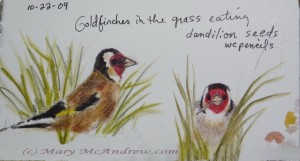 European Goldfinches The Goldfinches were neat, they kept landing in the long grass in front of my window and eating the dandelion seeds from the seed heads. It was funny to see this one bird with a seed sticking out of his beak, he’s twirl it around from one side of his beak to the other, it looks like a cigarette in the sketch! I used my watercolor pencils for this too, with a waterbrush.
This hike was such an adventure that I’ll never forget! It was long and had so many great views that I have quite a few photos to share with you before you see my sketch and watercolor painting at the end.
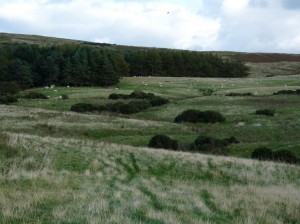 Hike up the valley First we parked the car near an old Medieval church that in itself is very interesting and I’d like to go back to explore it and it’s graveyard with old stones. We hiked up this valley along all those pine trees you see…past all those white dots, those are sheep!
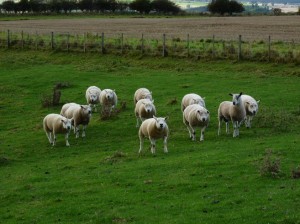 The tough looking sheep closed in on us I’ll be a little silly here and tell you when we walked past these sheep, they kept coming closer and closer like they were ganging up on us. It’s my silly side that thinks they look like thugs in tight wool sweaters, not very attractive sheep! The one who doesn’t have to short pig-like look is a different breed, he must be wondering what he’s doing with all those thugs! haha.
 The hill we need to climb We passed the sheep and went up a very gentle sloping hill, but it was huge so it took us awhile. It may look all sunny and pretty but it was really cold and extremely windy that day. You can see the beautiful line of Scotch pines up on the hill, that’s where we’re headed to the ring fort.
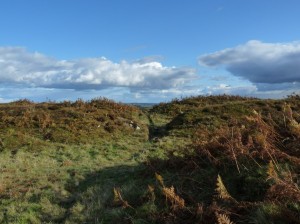 Old walls of the Celtic Ring Fort Well we made it up, the hill seemed to never have a top to it…we walked and walked but enjoyed the views. If you look at the photo above you’ll see a mound of dirt with grass on it, looks like a dune at the ocean, and there’s a spot you can walk through. That’s the Celtic Ring Fort entrance and the mounds are the walls, they used to be much taller and had deep ditches dug all around like a moat for protection. It’s such a huge site, it’s hard to imagine the layout of the fort, but if you look at it on Google Earth it’s really cool to see the image of the rings from above.
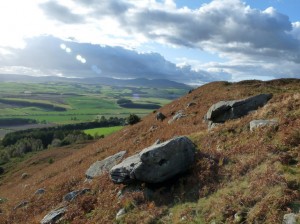 Steep hillside defense of the ring fort This is the view off the front of the hill fort, it’s a very steep hillside which would have given them protection from enemies. At the top of the hill you can just see several mounds of dirt, those are remains of the walls.
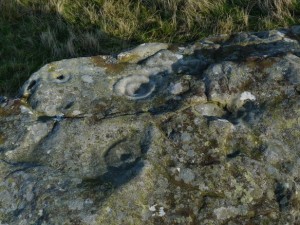 First stone we found Now this is the best part, there is ancient rock art on the stones found around this site. These were carved around 3,000 – 4,000 years ago by the ancient Celtic people who made the hillfort. They are generally called ‘Cup and Ring Marks’, the ones above are ring marks. It’s so beautiful to see the symetrical designs carved into the rocks but they are so worn with age and covered with lichens that they just look so natural.
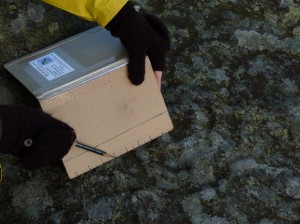 I'm measuring the rings with my sketchbook Here I’m showing how I use the ruler I drew on the back of my homemade sketchbook to measure one of the rings circumferences.
 This is the larger stone on Old Bewick This is the second rock we found and probably very photographed by hikers. If you do an image search for “Old Bewick Rock Art” you’ll come up with a lot of interesting stuff.
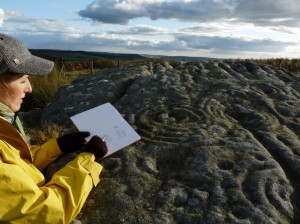 Drawing rings Here I’m sketching some of the rings of the second rock, gosh it was really cold, if you could only imagine it was hard to stand still because the wind was blowing on me so hard!
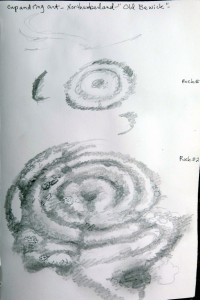 Sketch of the rings Here’s the sketches of ring marks. I tried to hold my pencil lightly and used the side of the tip so I could sort of lightly scribble the forms and build up darks as I went.
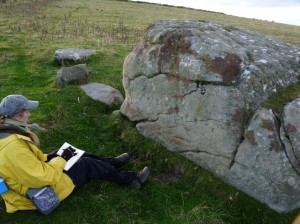 Drawing the line of 'cup' marks Just as we were getting ready to leave I looked back at the huge stone and noticed (with my keenly trained nature sketching eyes!!) the little ‘cup’ marks along the front of the stone.
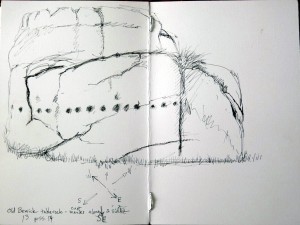 Old Bewick field sketch I had to go back, even though we were tired and ready to go, I sat and did a quick pen sketch with permanent ink of the outline and basic cracks.I’m just getting used to using my new homemade sketchbook and I like that I can draw across two pages instead of having a spiral in the way.
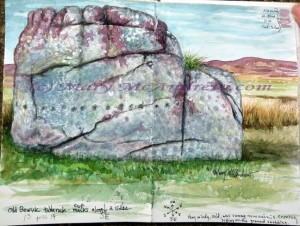 Painting of Old Bewick Rock This is the finished painting of Old Bewick Rock. Once I get home I only have my laptop to look at for reference from photos I take. As I now had time to sit in a warm house with a hot cup of tea I could see where I was a bit ‘off’ with my cracks and added maybe two extra cups marks! But it’s a field sketch, no big deal. So I had fun painting it with watercolors and you can see I left color testing notes in the upper right corner. While I sat there I did note the direction I was facing with my compass and wrote it on my paper.
I hope you enjoyed coming on a great hike with me, I’m inspired to study more of the numerous ‘rock art’ sites all around Northumberland and do some paintings.
I thought I should add a note here about the ancient sites like this, in case you ever visit one please remember they are irreplaceable. Gary and I talked about how soft the sandstone is and crumbles very easy if you just touch it. It’s my opinion that you shouldn’t really touch it too much or especially do rubbings on paper, I think it’s too much abrasion for the stone. Please never climb on it and encourage others to consider it’s delicacy too. Thanks!
Today we visited Howdiemont Sands beach along the coast of the North Sea in Northumberland England. We walked across Sugar Sands and climbed up to a point where we could view the point at Howick Haven. I wanted to sit and try to do a small watercolor landscape so I bundled up and brought the usual field kit.
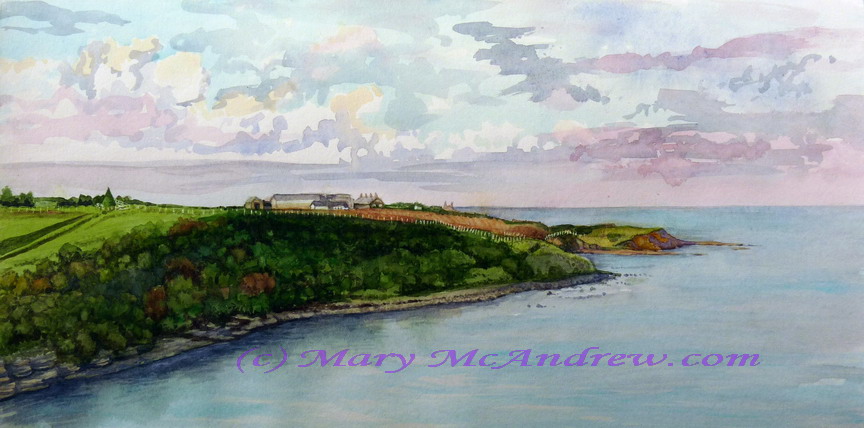 Water color painting "View of Howick Haven" Here’s the finished painting, I did most in the field sitting on top a windy, grassy cold hill. I’ll share the photographs with you of what I saw and tell you a bit about how I did the little painting.
 We walked along this beach When you first arrive at Howdiemont Sands you can choose to walk either right or left. We chose left because it was new to us and we always wonder at what new views might be found or other discoveries.
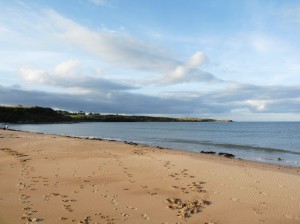 Sugar Sands The beach here (called Sugar Sands) is unbelievable, a pretty color of ‘sand’ shade, (hahah…) clean, soft and inviting even on a cold sunny October day. You can see many other people and their dogs found the beach irresistible today too.
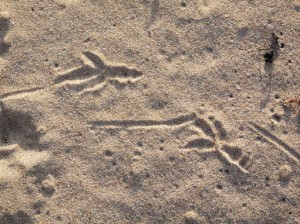 Bird tracks There were lots of interesting bird tracks too, gulls leave a track with a little web foot. This one? It was big and looked like it would drag it’s front toe in the sand when it stepped; I wish I knew what it was.
 Looking back at Sugar Sands Here’s a view looking back on the beach we crossed, sometimes you have to go up over the grassy banks to get past areas that are under water still.
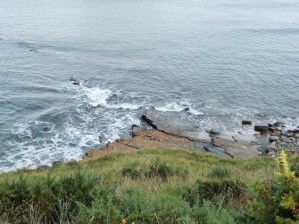 The red rocks below me This is looking down from where I decided to paint, how beautiful the patterns and colors are in these rocks. As the tide continues to go out the rocks will be more exposed.
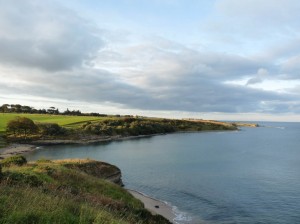 View from my painting spot This is the gorgeous view from where I decided to sit, light was fading fast and I had to pick a place quick. It’s really hard to pick a scene when there’s so much to see around you. It helps to hold up your hands and make a little opening like a rectangle and pretend that’s your paper. Move your hands around until you find a cropped scene that you like.
 View I painted Because I wasn’t working really big I tried to limit what I was going to paint, also I didn’t have tons of time with the sun leaving soon as it was about 4:30pm when we arrived.
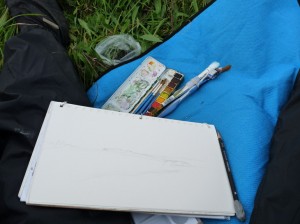 my sketch I sat on a picnic blanket with a waterproof bottom, wore my wind/rain pants over my regular pants, this helped to cut the cold and wind. I also had on my fingerless gloves as usual, sorry no picture today! I’m using a homemade sketchpad that I created so it would be extra long. It’s great for landscapes! I worked with my field pan and regular watercolor brushes, usually when in the field I use my waterbrush. I don’t like the waterbrush for larger works needing big washes of color. You can see in the picture a baggy just off the blanket, tucked into the grass. I forgot a watercup to rinse my brushes in, so I used a baggy with some water in it, it worked great!!
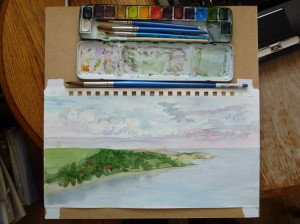 My watercolor field pan This is the painting/sketch laid out at home, you can see this is how far I got with it in the field. The pan watercolors I used is an old metal kit that I popped the large pans out of and replaced with half pans of Windsor Newton brand paints. I use a bit of sticky tack or blue tack to hold each one in place and you can see the handles on my brushes are cut, so I can fit more “things” in it. I brought that one long brush with me and used only that to do all this so far.
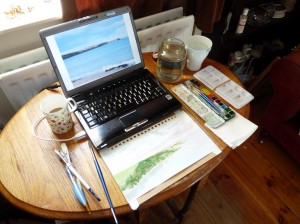 My set up to finish from photo at home Now I set up my laptop with a photo I took while there, and worked on details with smaller brushes while looking at it. I didn’t touch the sky, just left it the way I did it in the field. If you start to mess around with all of it, it can get stiff looking. Notice I put my coffee on the left side…if your right handed, water should go on that side and you don’t want to be dipping into your coffee by mistake! So, I worked on trees and details of that main area; I also used a razor blade to scrape fine lines for the white fence. Also, you may have noticed a funny looking cone shape that looks like a child’s’ painting of a tree? It’s a recreation of one of the oldest ‘houses’ in Britain probably from the Bronze age. Remains of one were found on this very spot! They made their homes from tree limbs in a sort of tee pee style, with turf for the roofing material. I’ll try to find a link about it to add here.
Go here to see the finished painting in the GALLERY.
To see other watercolor landscapes go to my gallery here: http://marymcandrew.com/gallery/landscapes/watercolors/
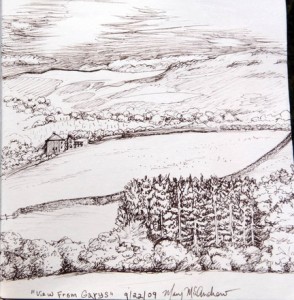 View from Gary's Another small sketch done in brown permanent ink pen (Micron) in my field sketchbook. This was done while sitting and waiting to leave for another adventure. It looks across a farmers field, where the tall pines and trees are is a Burn or stream, then behind that up the hill to more fields with a stone wall crossing it, a nice house and the wall along the top is for the B road that runs along the crags. Above it you can see the hill of crags with heather and bracken growing.
A beautiful view everyday.
I am not sure when I started to be fascinated by mushrooms and fungi, but when I go hiking I find I’m always stopping to notice them tucked away under branches, logs or leaves. Sometimes they’re right in front of you on the sides of dead or dying trees or right on the path, or they may be hiding waiting for your keen eye to catch them.
I spotted this pair right in the lawn (that needed cutting!) and what an interesting mushroom. My best guess is a “Shaggy Ink Cap”. I wondered why it was named that until I saw it a few days later.
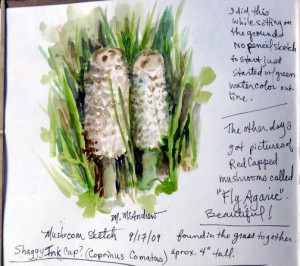 Shaggy Ink Cap watercolor sketch I did this little sketch with just watercolors, I wanted to avoid doing a careful pencil sketch and just kind of block in some green to form the light shapes of the mushrooms. I used a waterbrush which is handy but can be a bit limiting; it’s not as easy to mix quick pools of color in your pan and you must have a paper towel handy to clean between colors. Also I usually use just the one size waterbrush when doing a quick sketch so you use it to make wide and narrow lines or marks. The challenge on this set of fungi was the shaggy part, how to paint it without fussing too much? The “shags” were light and pointy, really their form was created by the darks around them…above and below. If I was doing a careful study I’d spend more time on that feature.
 Me working on the sketch Here’s a picture of me working to show my set up; I’m sitting on my blue foam pad because the grass is damp and chilly, it was early morning still. It’s not the best posture for someone with a ‘bad’ back, no support, but what are you going to do? That’s partly why I worked so fast, I get achy!
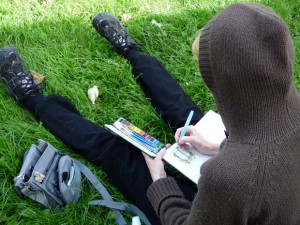 Looking over my shoulder You can see my new little field kit there, I use it as a purse and carry my bare essentials for field sketching. The art supplies take presedence I have to admit…no make-up just some money, credit card and the rest is for drawing! My motto, “Be Prepared”! I’m holding the watercolor pan in my left hand, waterbrush in the other. I have regular brushes in the pan in case I want to use them or have water with me.
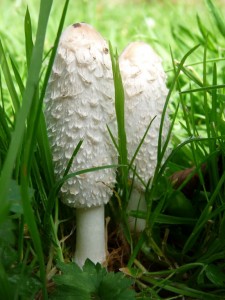 Shaggy Ink Cap This is how it looked the day I painted it.
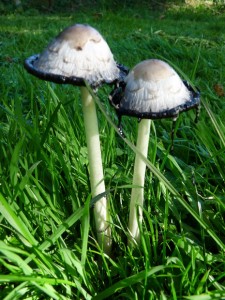 Two days later And this is just two days later, I was shocked! I guess that’s where it gets it’s name, INK cap. It was eerie looking, dripping black goo, like it had melted.
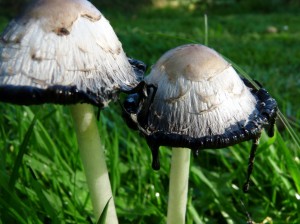 Two days later close-up I would like to learn more about this, and why it does that. Any of my readers know?… leave me a comment please. I didn’t have a chance to draw it at this stage, been too busy going off on hikes. I have been photographing many types of mushrooms, my favorite so far is the Fly Agaric…bright red cap with white flecks on it. I hope to do a painting of that one too.
On Sunday, September 20th, I went on a carriage drive with eight different buggy’s and all kinds of horses, through Coquetdale (or the Coquet river Valley) all around Rothbury.
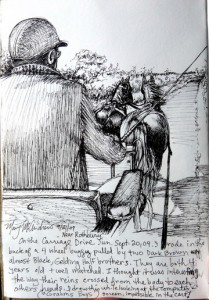 Graham's Boys This is a drawing I did after the drive while looking at one of my photos on the computer screen. It was WAY too bumpy to even consider sketching while on the drive. This was done with a permanent ink pen with no preliminary pencil sketch, so I had to plan as I sketched because you can’t erase.
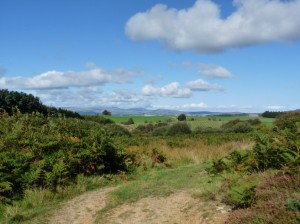 View above Coquetdale
A bit about the carriage drive. It’s hard to pick out just a few pictures. As you can imagine on an 8 mile pony trek through some of the most beautiful English countryside while in the back of a 4 wheeled horse cart, left me with lots of photos. The day was perfect, a bit breezy but no rain and no dark clouds!
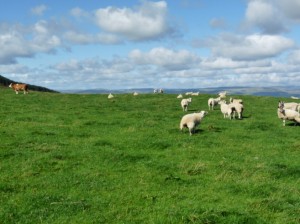 Sheep above Coquetdale Through a farmers field with gorgeous views of Coquetdale below.
I got to ride in a 4 wheel buggy as I said, pulled by a team of two, half-brother horses. They were perfectly matched though, both dark brown. They were only 4 years old so young by standards of experience and the owner, Graham, was thrilled at how well they did.
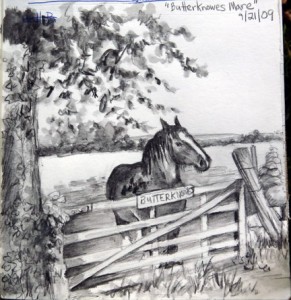 Butterknowes Mare This is a water color pencil sketch I did once again after the drive. I used one black pencil and a waterbrush to do it. It was a mare in the field we passed, the gate read, “Butterknowes”, that’s the farm name. Any time we passed a field with horses they all galloped around and bucked, you could feel their excitement! This mare had a foal and they did the same thing, running along the fence as we passed, it was really exciting.
Driving a buggy can be dangerous stuff though, all in the cart had riding helmets on in case of a tip over, me…well I didn’t have one. I had to just hope the horses and terrain would cooperate! There were some parts where we had to duck from tree branches over an old railway line, where the steep bank was just a step away; and parts where the road was so bumpy I held myself up off the seat by partial standing and using my arms. I just couldn’t take the bumps with my back. But other than that it was relaxing and fun.
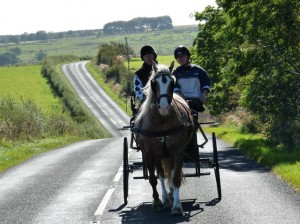 On the highway This is the buggy that was just behind us in the first part, then we switched positions so our horses could feel secure and follow.
We went through farmers fields, on a two lane paved ‘highway’, on old railroad lines, on country dirt roads (complete with pot holes!), through many field gates, up past the Simonside Hills and moors covered with bracken and heather, to swing down through gorgeous mature pine forests and then into Rothbury, a quiet little town in Coquetdale (the River Coquet valley).
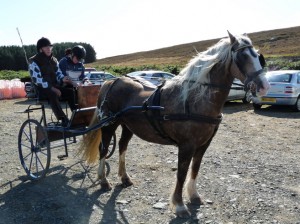 Pausing at the parking area of Simonside We had a brief pause at the parking area near Simonside in the open moorland areas. We were trying to let the others catch up. It was windy and cold up here, but we couldn’t stand long or the horses would chill.
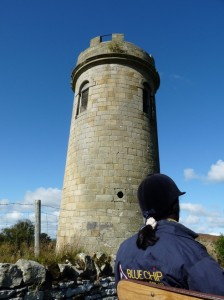 Tower at Rothbury This is the old tower just outside of Rothbury, I’m not sure if it was used to look out for invading Scots or not? I have to find out.
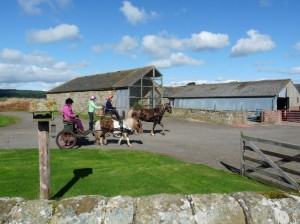 Coming home Everyone filed in after the drive to June’s farm at East Raw, June’s the shepherdess who hosted the drive. The buggy in the back with the gorgeous chestnut horse is June with her groomswoman (or gate opener!) Becky. The cart in front is a lady from Scotland who came down just for the drive, with her Shetland Pony.
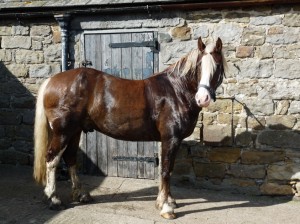 Chester sweated What can I say? Is this not a perfect looking horse?! (June’s horse Chester)
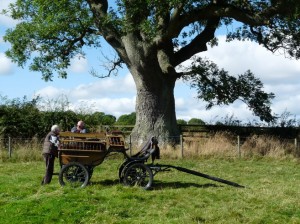 After the drive I’ll leave you with this picture of the buggy I rode in, with these two chaps having a talk over it, under a huge ancient tree. Sigh…a perfect day. I feel some horse paintings coming soon.
We went to Berwick-Upon-Tweed, on the Scottish border on two occasions. I found it to be a nice town to walk through, you can shop or just a few streets over is the water front, complete with an old fort you can walk about on. It’s on the River Tweed and that’s where it gets it’s name.
 Berwick-upon-Tweed unfinished The first visit I only had time to start a small watercolor of the houses in the town while sitting on the grassy wall of the fort. Here it is unfinished above.
 Berwick cemetery gate This is an old gate to the cemetery of a church right behind the grassy walls of the fort. I didn’t have much time to do a nice painting but really just wanted to study the colors of the stones used in the wall. I also didn’t have the nice sunshine you see coming through the gate while I worked, it popped out just for the photo. If I ever have time I’ll go back to the sketch and add more details in the stones from my photos.
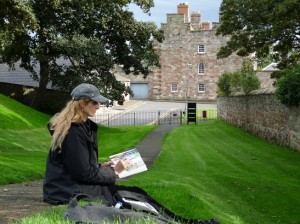 Painting the gate Here’s a picture of me working on the gate, you can see I’m sitting on the grass but am using a foldable foam pad to keep the moisture and chill away. I still always get so stiff when I sit on the ground like this, I think it’s the position for my back, no support. I’m holding my sketchbook with the pan of colors on the left hand side. I’m also using a ‘real’ brush not my waterbrush to do this, I have a container of water sitting on the ground nearby.
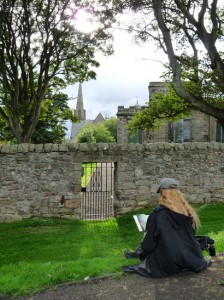 Painting the gate view 2 Below are some photos of the biuldings in Berwick-Upon-Tweed
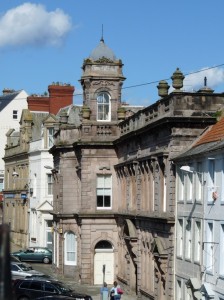 biuldings in Berwick 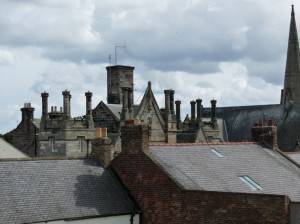 Town Hall 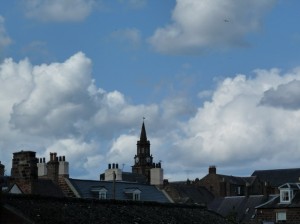 Skyline of Berwick
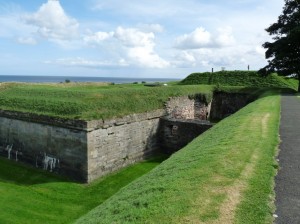 Tweed Mouth Dock Fort This is the fort in Berwick called Tweed Mouth Dock.
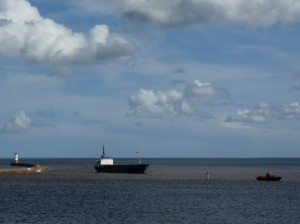 Ship coming in Here’s a ship coming into harbour.
Hopefully I’ll get another chance to go back and work on some longer studies. It’d be a nice town to spend a weekend in, I saw lots of couples walking about hand in hand going to shops.
Keep checking back, more updates from England coming!
The feeling of standing on top of a cliff with the wind blowing through your hair, out to the North Sea, can really clear your mind, your body and your soul.
 Standing on Scottish Soil Leave behind all worries, breath deep and let go, (just don’t let go of that nice shawl that you’re holding as the wind whips!)
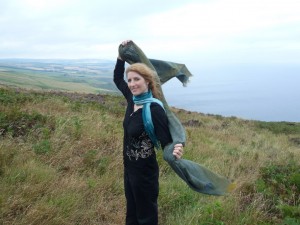 Clear your mind, your body and your soul. The beginning of any good journey should have some time to assimilate and absorb, relax into the moment and be happy.
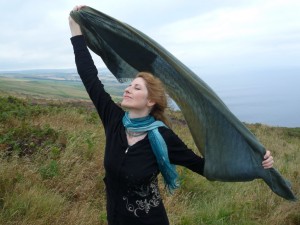 Breath deep and let go! Don’t just rush into it with a vengeance, you’re probably too tired from the flight anyways!
We had fun shooting these pictures on the drive down from Edinburgh to Northumberland. The day was windy, cloudy and cold, but it felt so good to be out in the fresh air and know that I was there at last. My wonderful boyfriend Gary shot these photos of me, he shares my love of nature and the countryside.
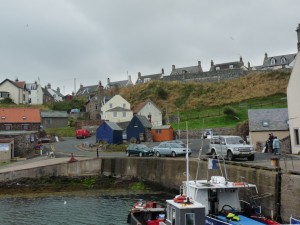 Town of St. Abbs on Scottish east coast On our drive we stopped at some small port towns, watching the fishermen’s boats and thinking of how tough that life must be. This is in the town of St. Abbs in Berwickshire Scotland, in what they call the Scottish Borders.
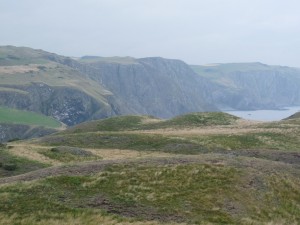 St. Abbs Wildlife Reserve Then we stopped at St. Abbs Wildlife Reserve along the coast. It’s very exposed but popular for bird watching and seeing the beautiful cliffs. We sat for awhile in the car looking out to take a break from the cold wind, while we sat I spotted a Stoat just running along the top of the bank you see in the photo. Gary said it’ll be after rabbits, it was an attractive animal, one worth doing a little painting of.
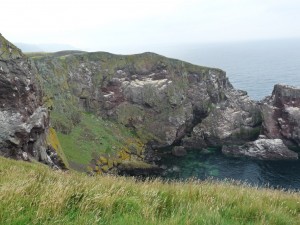 Stepping closer to the edge We walked around and then closer to the edge, being very careful of course! The water was a gorgeous deep aqua blue color and the cliffs were a flurry of activity from the birds coming and going.
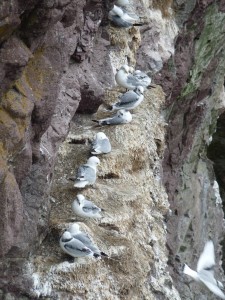 A row of Kittiwakes on the cliff face A nice neat row of gulls. At first glance I thought these were black headed gulls in winter plumage because they have the tell tale spot behind the ear. (Ah…didn’t wash behind the ears, don’t tell mom!) But when I looked in my field guide (“The Hamlyn Guide to Birds of Britain and Europe”) I saw that they have yellow legs and a light beak. When you bird watch the fun part is deciphering the markings of birds and figuring out what kind of bird it’s NOT. Process of elimination many times is what works. See more description below.
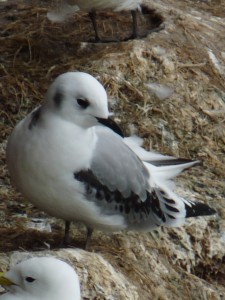 Immature Kittiwake 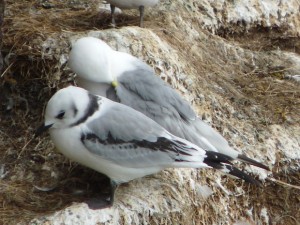 Kittiwake immature + adult At first it looks like two different species of birds, but the one in the forground is an immature and the one behind is an adult, both Kittiwakes. They have both have black feet, the immature has a partial ring around the back of it’s neck a black spot behind the ear and a black beak; the adult has a yellow beak. It’s like solving a puzzle, that’s why I like birding. Though I am NO expert by far, especially at shore birds as I don’t get to see them often. But I like to show how you can enjoy them and figure out what kind they are by looking up clues in your field guide or going online to search.
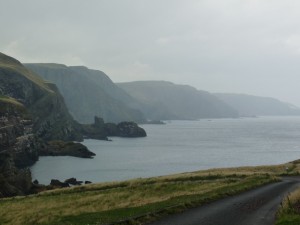 More of the northeast coastline Well here’s one last photo of the coast.
Please sign up your email in the box at the RIGHT > to receive notice of when I put up new posts. More coming soon!
|
Welcome to my Blog! The most up to date information about my artwork, nature sketching adventures, or step by step demonstrations. Search using Categories or Tags, or use the search box in the left column.
Please sign up below to get notified when I post new articles.
|










































































